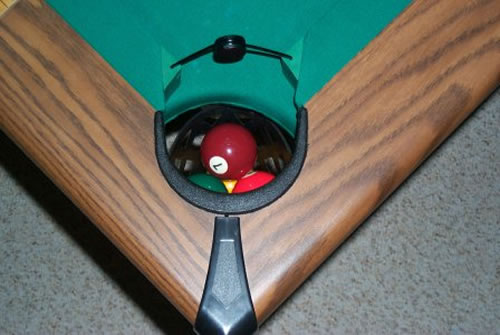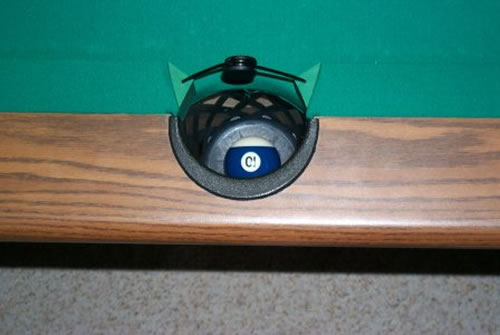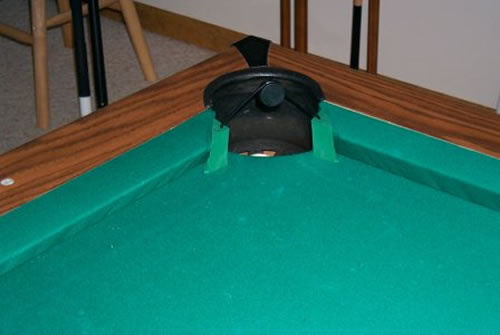Practice Pro Pocket Reducers
Among the gim-cracks I bought at Valley Forge were these pocket reducing thingies. Even though my home table is double shimmed the pockets are still a little on the generous side so I figured I'd try these out instead of triple or quadruple shimming my pockets.
Please note that this entire section about the pocket reducers was written well before I got my Pro-Cut Diamond table. My pockets are far from generous. If, in the mood for punishment, I were to put these pocket reducer doodads on my Diamond table I'd guess that I've have about 1/2" left for the balls to go through.
These are clever little doodads - a piece of rubber at each end of a spring-loaded wire. They come in a set of six so you can practice games with them instead of, for example, just reducing a single pocket and shooting drills into it.

To install, just bend the (surprisingly strong) springy wire and jam the rubber pieces into your pockets. On corner pockets you can set them up flush with the rails but the triangular shape of the rubber pieces means that they don't fit flush into the side pockets.
On my table the pockets are reduced to 3.5" for the corners and 3.25" inches for the sides. What's even more restrictive than the openings themselves is that the rubber pieces will reject just about any contact at all, so pocketing a ball is a lot tougher that it would be with normally-shimmed pockets of the same dimensions.
Speaking of contact, these things do a pretty good job of staying in place even after being hit pretty hard. At least they don't get knocked loose and go flying around the room putting peoples' eyes out. I generally check and correct their alignment with the cushions as I'm pulling balls out of the pockets.

They do stick up from the rails a couple of inches so they force you to either elevate your butt or, in some cases, stroke the cue under the wire. I've become pretty paranoid about scraping my new cue on them as I shoot.
At first, because of the absolute intolerance the rubber pieces show for inadvertant contact, these things seemed to make things too tough for me to get any enjoyment out of them. After a few hours, however, I've adjusted to them enough that they provide a good challenge without being overly restrictive. When I run a rack of balls through these things I know I've accomplished something.

One of my shortcomings is that I never remember what I pay for things, but these weren't too expensive, and IMHO a pretty good deal for whatever the money was.
Elephant Practice Balls
Got these just to show my cousin how hard it is to hit the ball where you want. They serve that purpose pretty well. One thing about them is that I've found it next to impossible to have the ball bounce off a rail without picking up a noticeable wobble. Perhaps this is due to some fault in my stroke - nah.
Jim Rempe Practice Ball
This is fairly useless for anyone except a beginner. The same concept as the Elephant Practice Balls but with concentric circles indicating tip widths from center. I defy anyone to hit the two outermost circles without miscuing.
Extend System Bridging Contraption
I've used this about 3 times in the 5 years I've had it. Takes up a lot of space and so far the only case I've found that'll hold the grip section is the Silver Fox BR-2 case.
Buddy Hall's Cue Guide
A little tube you're supposed to practice stroking through. Might be useful for mechanical players but the tube's too narrow for my tastes. Also, since the tube is so low to whatever surface you place it on you can't even practice with it on a pool table since the rails force you to elevate your butt slightly.
Elephant Beautiful Balls
I bought these 'cause I think they look pretty cool plus I got a great deal on them. Both the guy who sold them to me and another person who used to work for Elephant Balls told me that the cue ball would not hold up, so I picked up an extra red circle cue ball to use with this set. The balls seem to play about the same as my Aramiths and Centennials but they have one annoying quality that I may not be able to get used to. They are very LOUD. The "click" that normal balls make has been replaced by a very loud "CLACK." In fact, the sound is so different that breaking these balls apart sets off the glass breakage detectors in my home security system. I have a feeling I'll only use these balls for parties and such - or if I ever play in a tournament that will use these balls.
Various Cue Balls
Along with the Red Circle, Red Dot, and Blue Circle cue balls that go with my ball sets, I also have an extra large cue ball and a mud (extra heavy) cue ball for practice. Since I hardly ever play in bars anymore these don't get much use.
Bat Bridge - AKA Moose Bridge
This is probably the most clever gim-crack I've ever used. It slips onto my break cue and keeps me from having to use those damn metal bridges found in pool halls.
Original Pocket Chalker Chalk Holder
No matter what everyone else says these were invented in the Seattle area by Beads and Billiards. Everything else is a knock-off. I remember back in '98 or '99 going to Seattle and everybody had one of these things dangling from their pocket. I just had to buy one so I did.
Mirror Banking Thingies
I think these were made by CueSight but I don't see them on their site so I'm not sure. This is a set of six mirrors that you put under each rail. Then if you hold your head just right you can see the mirror-images of the pockets you're banking at. They don't interfere with the balls and they're really quite cool. Unfortuately, here on planet Earth, banks don't behave like light rays bouncing off mirrors, so these mirror thingies can only be used for very soft shots.





